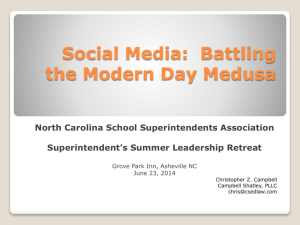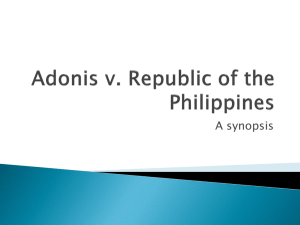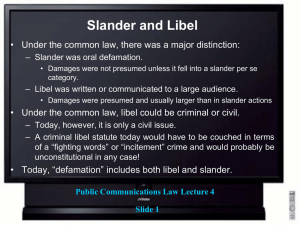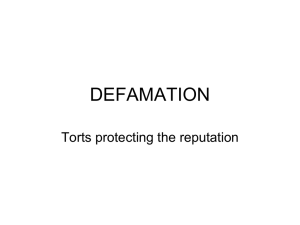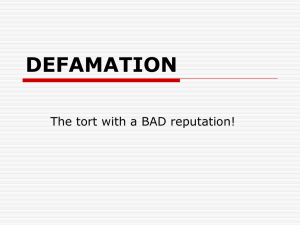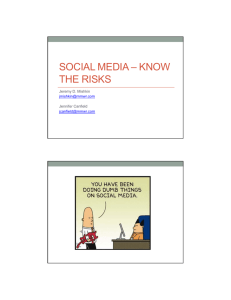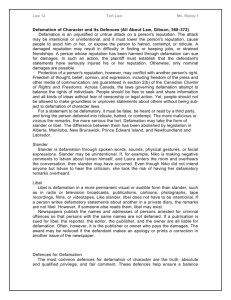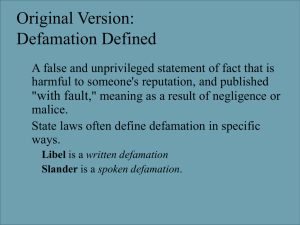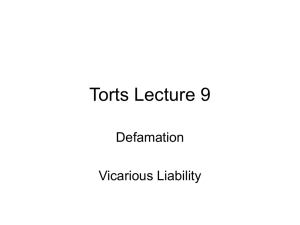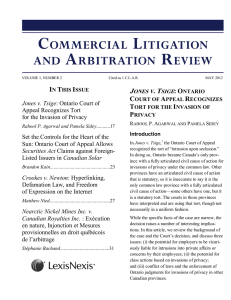CS Deepak P. Singh DEFAMATION
advertisement
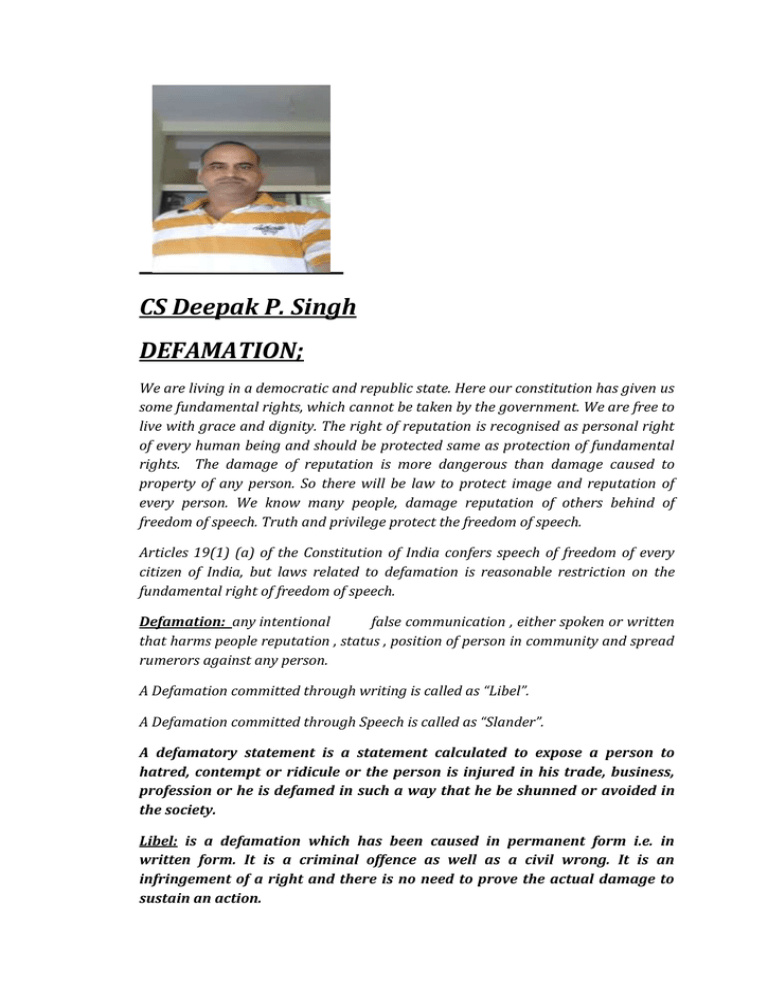
CS Deepak P. Singh DEFAMATION; We are living in a democratic and republic state. Here our constitution has given us some fundamental rights, which cannot be taken by the government. We are free to live with grace and dignity. The right of reputation is recognised as personal right of every human being and should be protected same as protection of fundamental rights. The damage of reputation is more dangerous than damage caused to property of any person. So there will be law to protect image and reputation of every person. We know many people, damage reputation of others behind of freedom of speech. Truth and privilege protect the freedom of speech. Articles 19(1) (a) of the Constitution of India confers speech of freedom of every citizen of India, but laws related to defamation is reasonable restriction on the fundamental right of freedom of speech. Defamation: any intentional false communication , either spoken or written that harms people reputation , status , position of person in community and spread rumerors against any person. A Defamation committed through writing is called as “Libel”. A Defamation committed through Speech is called as “Slander”. A defamatory statement is a statement calculated to expose a person to hatred, contempt or ridicule or the person is injured in his trade, business, profession or he is defamed in such a way that he be shunned or avoided in the society. Libel: is a defamation which has been caused in permanent form i.e. in written form. It is a criminal offence as well as a civil wrong. It is an infringement of a right and there is no need to prove the actual damage to sustain an action. Slander; - is a defamation of transit nature, by speech or by gesture. It is a civil wrong but the words me be blasphemous, seditious or obscene and this is a criminal offence under Section 499 of IPC. A Slander is actionable only when special damage can be proved to have been its natural consequence, or when it conveys certain imputations. ESSENTIALS OF DEFAMATION; - the essential ingredients of defamation are; 1. The statement must be false and defamatory, 2. It must be published, and 3. It must refer to the plaintiff. 1. As decided in case of Sim v. Stretch, (1936) 2 AII ER 1237, it was observed that the defamatory statement must be such which tend to lower a person in the estimation of right thinking members of society generally. A right thinking man is a reasonable man who is neither usually suspicious nor usually naive and he does not always interpret the meaning of words as in case of a lawyer since “ he is not inhibited by a knowledge the rules of construction.” 2. Yoissoup v. Metro-Goldwyn Mayer Pictures Limited, AIR 2001 Mad 225:- the plaintiff a Russian princess was falsely imputed by a cinematograph film that she had been raped or seduced by the notorious monk Rasputin. The Court observed that the film was tended “to make the plaintiff be shunned and avoided” in the estimation of right thinking person in the society generally. INNUENDO; - It means a remark with double meaning. Sometimes it happens that a statement does not convey any defamatory imputation it its natural meaning, but it may convey a defamatory owing to the particular circumstances and these particular circumstances by the plaintiff, is called innuendo. 3. As decided in case of Cassidy v. Daily Mirror (1929) 2 KB 331 , the newspaper , Daily Mirror published a news with a photograph of Mr. M and Ms. C together with the news caption that Mr. M the race horse owner and Ms. C has announced their engagement. But news was false as they were already married. The wife of Mr. M., the plaintiff brought an action against the daily on the ground that the publication was capable of conveying a meaning defamatory of the plaintiff. It means that she was not a lawful wife of Mr. M and she was living with Mr. M. In immoral cohabitation. The daily news paper was held liable for defamation. 4. In cases of defamation the intention of the defendants and his/her knowledge on the matter is important. As in case of T.V. Ramasubba Iyer v. Ahmad Mohideen, AIR 1971=2 Mad 398 in this case the defendants published in their newspaper that the plaintiff an exporter of scented sticks ( agarbatties) to cylone had exported opium and other drugs and was kept in the custody of Cylone Police and brought to Madras. On an action brought by the plaintiff for defamation the defendants pleaded that they have no intention to defame the plaintiff and the news was published without their knowledge. The Madras High Court in this case had been decided that the defendants were not liable for defamation. 5. Now in case of D.P. Chaudhary v. Manjulata, AIR 1997 Raj, 170 , a news was published in local daily that the plaintiff Manjulata, a 17 years old, student of BA and girl from distinguished family has been eloped with a boy named Kamlesh on the pretext of attending night classes. The Court found that the news was totally unreasonable and false and had defamed the reputation of college going girl and her family. The daily paper was held guilty of libel. If any person knowingly sends something in writing to defame a person in a close envelop that it will be opened by someone else, then this amounts to publication and it is a defamatory act. 6. Wenman v. Ash (1953) 13 CB 844 in the eyes of law, husband and wife are one entity hence something written defamatory by husband to his wife or vice-versa doesn’t amount to publication. But communication of defamatory statement by a third party to either husband or wife are publication on the ground that although husband and wife are one person, they are not so for the purpose of having the honour and feelings of the husband assailed and injured by acts done or communication made to wife. 7. Shilpa S. Shetty v. Magna Publication Co. Ltd. AIR 2001 BOM 176; filed a suit claiming damages for the articles, published in the magazine published by the appellants called Stardust, are defamatory in nature and would affect her carrier and for injunction restraining the appellants for publishing defamatory articles. The learned judge while reading article finds out that the it was defamatory and grant injunction as pleaded by the plaintiff. Note: in case a defamatory statement are repeated by the defendants, then on each publication a new case rises and defendants will be libel for the same. It is duty of the plaintiff to prove that the defamatory statement is brought to defame him/her or reduce his/her position in the society. If a publication is held to defame a group or class of person, then any one of them can bring the suit of defamation on behalf of class or group of person. Note: to defame tort is not a tort. But if some one proves that the defamation of deceased person affects his/her reputation in the society then it become defamation. Suppose Mr. X makes a defamatory statement that Mrs. Y is a prostitute and Ms.Z daughter of Mrs. Y brought a suit of defamation against Mr. X, then Mr. X will be liable in case of Slander. DEFENCES AVAILABLE; which are; 1. Justification, 2. Fair comment and; 3. Privilege Note: if publication of statement is in public interest. It was issued in welfare of the public or to protect the public to save them or keep them aware from that person. Note: a bonafide comment is the second defence to an action for defamation. The comment must be a comment not statement of facts. The comment must be in public interest. The facts must be revealed before publishing statement. The comment should be fair or honest comment and true with the circumstances. Note: on some cases it is necessary to provide information or give speech regarding any person without any fear of an action for defamation. Such as in case of complete freedom of communication. In case of parliamentary, state legislative proceedings or in such proceedings where it is necessary to speak truth without fearing suit of defamation. In judicial proceedings also it is necessary to speck truth about any person whether it is defamatory or not.

